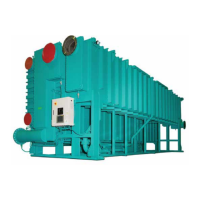JOHNSON CONTROLS
156
FORM 155.30-ICOM2.EN.UL
ISSUE DATE: 12/21/2018
SECTION 8 – TROUBLESHOOTING
TABLE 35 - TROUBLESHOOTING THE HIGH TEMPERATURE GENERATOR
ITEM CAUSE COUNTERMEASURE
1
Cooling water is insufcient or
suspended
• See if the cooling water supply rate matches the specication.
•
Check the ow meter, discharge pressure of the cooling water pump, current,
and other relevant pumps.
•
If the ow rate is insufcient, check the opening ratio of the ow controller valve
and check the strainer for clogging.
2
Cooling water temperature at
inlet of absorption chiller is
high
Check the capacity of the cooling tower.
3
Hot water temperature at inlet
of absorption chiller is high
Check the hot water inlet temperature. If it is higher than the specication, change
the set temperature to the specication.
4
Non-condensable gas stays in
machine
• See Purge Procedure on page 130.
• Check the capacity of the vacuum pump.
• Check the purge unit for trouble.
• Purge air from the absorption chiller.
•
If partial-load operation is continued for a long period, non-condensable gas
tends to stay in the absorber. In this case, purge directly from the low-pressure
side (absorber).
5
Heat exchange tube is dirty
(Chilled water, cooling water)
Contact your local Johnson Controls Service Ofce.
6 Solution is crystallized
7 Corrosion inhibitor is worn
8 Air leaks in absorption chiller
TABLE 36 - CHILLED WATER OVERCOOLING OR REFRIGERATION OVERCOOLED
ITEM CAUSE COUNTERMEASURE
1
Chilled water ow rate lowers
or changes sharply
See if the chilled water ow rate changes suddenly (particularly in the case
of variable ow rate specication). If it changes suddenly, apply a limit of the
change rate to the chilled water ow control or take another measure.
2
Cooling water temperature at
inlet changes sharply
See if the cooling water temperature at inlet changes sharply (by checking start
and stop of the fan). If the chilled water or the refrigerant temperature is low,
the chiller stops immediately but does not perform the dilution operation. If left
as is, the solution will crystallize in 4-5 hours. To prevent this, dilute the solution
according to the procedure shown in Manual Refrigerant Blowdown and Diluting
Method on page 135.
3 Load lowers sharply See if the load changes sharply.
4
Refrigerant is dirty (contains
solution)
See if the refrigerant rening operation has been performed periodically. For the
refrigerant rening method, see Refrigerant Rening Method on page 135.
5
Heat exchange tube is dirty
(Chilled water)
Contact your local Johnson Controls Service Ofce.
6
Temperature controller or
safety switch is broken

